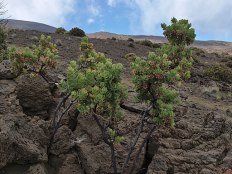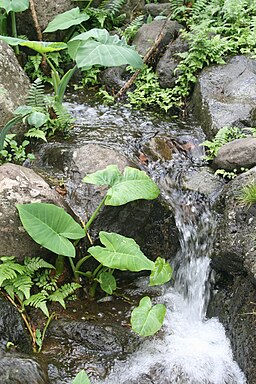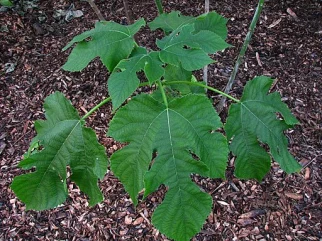In last month’s post, one of the featured origin stories for the arrival of the breadfruit tree (Artocarpus altilis) in Hawaii told how it had grown from the body of a dead man. Following on from that, this month I will be looking at three more plants which, in Hawaiian folklore and mythology, sprang from bodies of the dead.
The first plant is the ohelo bush (Vaccinium reticulatum), found growing in volcanic terrain and considered sacred to Pele, goddess of volcanos and fire. In mythology, ohelo grew out of the body of Kaʻōhelo, Pele’s human sister (Beckwith, p. 99).

Next there is the lauloa taro (a member of the Colocasia esculenta family) used by the ancient Hawaiians for both food and medicinal purposes, came from the body of the stillborn child of the goddess Hoʻohokukalani, and her father, Wakea, god of light.

Another staple believed to have grown from a human corpse is the wauke (Broussonetia papyrifera) or paper mulberry, which grew from the body of Maikoba, son of Konikonia, ruler of Waiakea in Hila. Wauke is one of a number of plants used for making kapa cloth and, just as Maikoba was reputed to be particularly hairy, wauke produces a hairy kind of kapa (Ibid., p. 99).

The flora mentioned above sprang from the bodies of those closely associated with the gods or prominent chiefs. Although the breadfruit tree in post no. 94 grew from a man who died to save his family, and I’ve found no mention in the sources of any links to the Hawaiian elite or the gods, he still died a noble death. It would be interesting to find out if any Hawaiian plants grew from the bodies of ordinary folk who died in more mundane circumstances.
Next time…. I’ll be looking at the sinister reputation frogs have in Jamaican spirit lore.
Sources
Martha Warren Beckwith, Hawaiian Mythology (reprint, with a new introduction by Katherine Luomala, Honolulu: University of Hawaii Press, 1970, of orig. edn, New Haven & London: Yale University Press, 1940).
Lauloa taro: https://bentut.github.io/kupunakalo/index.php/kalo_varieties/detail/lauloa_keokeo/index.html <accessed 1.4.24>
Image credits: Ohelo by Jim Morefield, CC BY-SA 2.0, via Wikimedia Commons
Taro leaves growing by a waterfall in Maui by Paul Harrison, CC BY-SA 4.0, via Wikimedia Commons
Broussonetia papyrifera by David Eickhoff, CC BY 2.0, via Wikimedia Commons